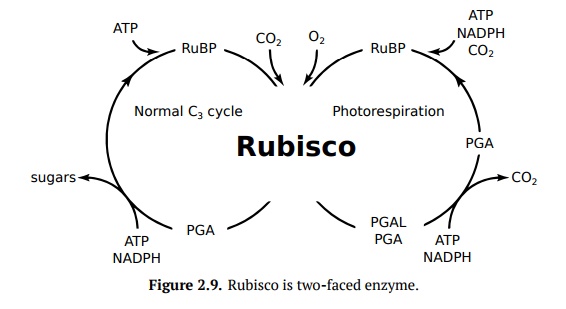Chapter: Introduction to Botany: Photosynthesis
Photosynthesis: C4 Pathway
C4 Pathway
Rubisco is the enzyme of extreme importance
since it starts the assimilation of carbon dioxide. Unfortunately, Rubisco is
“two-faced” since it also catalyzes photorespiration (Fig. 2.9). Photorespiration
means that plants take oxygen instead of carbon dioxide. Rubisco catalyzes
photorespiration if there is a high concentration of oxygen (which usually is a
result of intense light stage). Rubisco oxygenates C5 (RuBP) which turns
into PGA and PGAL, becoming glycolate. This glycolate is returned to the Calvin
cycle when the cell uses peroxisomes and mi-tochondria, and spends ATP. The
process of photorespiration wastes C5 and ATP which could be more
useful to the plant in other ways.

If concentration of CO2 is high
enough, assimilation will overcome photores-piration. Consequently, to minimize
the amount of photorespiration and save their C5 and ATP, plants
employ Le Chatelier’s principle (“Equilibrium Law”) and increase
concentration of carbon dioxide. They do this by temporarily bond-ing carbon
dioxide with PEP (C3) using carboxylase enzyme; this results in C4
molecules, different organic acids (like malate, malic acid) with four carbons
in the skeleton. When plant needs it, that C4 splits into pyruvate
(C3) plus carbon dioxide, and the release of that carbon dioxide
will increase its concentration. On the final step, pyruvate plus ATP react to
restore PEP; recovery of PEP does cost ATP. This entire process is called the “C4pathway” (Fig. 2.10).

Plants that use the C4 pathway waste
ATP in their effort to recover PEP, but they still outperform photorespiring C3-plants
when there is an intensive light
and/orhigh temperature and consequently, high concentration of oxygen. This
is why inthe tropical climate, C4-crops are preferable.
Two groups of plants use the C4
pathway. Many desert or dryland plants are CAM-plants which drive the C4
pathway at night. They make a temporal
sepa-ration between the accumulation of carbon dioxide and photosynthesis.
CAM-plants make up seven percent of plant diversity, and have 17,000 different
species (for example, pineapple (Ananas),
cacti, Cactaceae; jade plant, Crassula
and their relatives).
“Classic” C4 plants drive C4
pathway in leaf mesophyll cells whereas their C3 is located in
so-called bundle sheath cells. This
is a spatial, rather than tem-poral
separation. These C4-plants make up three percent of plant
biodiversity and have more than 7,000 different species (for example, corn, Zea; sorghum, Sorghum and their relatives).
In all, both variants of C4 pathway
relate with concentration of carbon dioxide, spatial or temporal (Fig. 2.11). Both are called “carbon-concentrated
mecha-nisms”, or CCM.
There are plants which able to drive both C3
and C4 pathways (like authograph tree, Clusia), and plants having both “classic” C4 and CAM
variants (like Portu-lacaria).

Related Topics